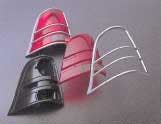Making prototypes quick and right
Rochester Hills, MI-North American Lighting Inc. (NAL) and its Technology Center in Farmington Hills, MI, were charged with providing the tail lamp assembly and developing the prototypes for the 2004 Mercury Monterey minivan. With time short, Scot Turner, NAL prototype manager at the Tech Center, needed to provide Monterey team members with production-quality parts for final review and approval.
“For us to have a high level of assurance that the prototypes would as close as possible simulate production output and production processes, they have to be produced using tool designs, materials, and machines that approximate high-volume manufacturing. Because the development time schedule was tight, we needed the parts done fast. For both of these reasons we went to Urgent Plastic Services to have the prototypes made,” Turner says.
Urgent Plastic Services (UPS; www.urgentplastics.com) is a specialist in the rapid prototyping of injection molded plastic components. For more than three years the company has been working with automakers and suppliers to provide prototype lighting components for new models and concept vehicles, including cars, SUVs, and trucks. More recently, the company has added the ability to create light lenses with actual, production-quality reflex characteristics. The rapid part of the equation means that, in virtually all cases, through the use of advanced technologies, materials, and creative thinking, prototype parts are completed from 50 to 70 percent faster than traditional technologies and prototype manufacturing methods would allow.
A project typically begins with the customer’s submission of part(s) design and, as was the case in the tail lamp application, a CAD file. After the computer designs were approved and any engineering analysis required was completed, UPS sent the design files to one of its stereolithography apparatus (SLA) systems for producing three-dimensional models of parts. Such systems typically complete models in a few hours. SLAs use the CAD data file to generate a dimensional travel path for a laser light source that cures a photosensitive polymer into the size and shape of the part.
For the NAL/Monterey project, the resulting three models were used as a “hands-on” reference tool for checking fit and for aesthetic review by design and styling experts.
After mold approval, the next step in UPS’s rapid prototype process is usually building of injection mold dies. For this Monterey light application, the molds were machined from aluminum alloy, and, as with the SLA system, the CAD files generated the path for the machining centers’ cutting tools.

